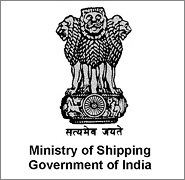Website shipping.nic.in Cabinet minister Nitin Gadkari | Jurisdiction India Programs Sagar Mala project | |
 | ||
Annual budget ₹1,773 crore (US$260 million) (2017-18 est.) Ministers responsible Nitin Gadkari, Minister of Transport
Pon Radhakrishnan, Minister of State for Shipping
Mansukh L. Mandaviya, Minister of State for Shipping Headquarters Parivahan Bhavan, 1, Parliament Street, New Delhi - 110 001 Minister of state Pon Radhakrishnan, Mansukh L. Mandaviya Profiles | ||
The Ministry of Shipping, a branch of the Government of India, is the apex body for formulation and administration of the rules and regulations and laws relating to Shipping. From 2014 this department is under Transport minister Nitin Gadkari.
Contents
Introduction
Maritime Transport is a critical infrastructure for social and economic development of a country.It represents the pace,structure and pattern of development of water transport in the country.The Ministry of Shipping encompasses within it the shipping and port sectors which include shipbuilding and repair,major ports,national waterways and inland water transport.The ministry has been entrusted with the responsibility to formulate policies and programmes on these subjects and their implementation.
History
In July 1942, the Department of Communications was split into two departments as the Department of Posts and the Department of War Transport. The Department of War Transport included major ports, railways, roads, water transport, petrol rationing and producer gas. The functions of this department were to manage the transportation during the war times. Coastal shipping and the management and expansion of major ports was also added to the portfolio. Further, exports were given priority in the department.
Changes over years
Post the independence of India in 1947, various governments have reorganized and renamed the department.
Organisational setup
Directors,Deputy secretaries,Under Secretaries and other Secretariat and Technical Officers.
The following are autonomous organisation,societies and PSUs functioning under the administrative control of the ministry:
Subordinate/Attached offices
Autonomous bodies
Societies and associations
PSUs
Statistics
India currently ranks 16th among the maritime countries with a coastline of 7,517 km with 13 major ports (12 government and one corporate) and about 200 non-major ports currently operating in western and eastern region of the country. According to the ministry 95% of India's trade by volume and 70% by value happens through maritime transport.
Market size
Cargo traffic of Indian ports were 911.5 MT for FY12,and is projected to be around 1,758 MT for FY17. During April–May 2014 ports handled 95.87 MT of cargo as compared to 91.48 MT during April–May 2013, an increase of 4.8%, according to the data released by Indian Ports Association (IPA).
Of the major ports, Mormugao Port posted highest growth in traffic (24.48%) during April and May 2014,followed by Mumbai Port (14.35%), Kamarajar Port (13.90%), V.O. Chidambaranar Port (13.67%) and Kolkata Dock System (12.36%) as compared to the same period last year.In terms of volume, Kandla port led the pack with 15.31 MT of traffic handled followed by Paradip port at 11.73 MT during the same period.
In 2013-14, coal cargo traffic (thermal coal and coking coal) volumes rose by 20.6 per cent to 104.5 MT from 86.7 MT a year ago.Among commodities, there was an increase of 25 per cent in handling of fertilizers in April 2014 in comparison to April 2013. Iron ore handling has also shown an increase of 16.8 per cent during the month.
Investments
The Indian ports sector received FDI worth US$1,635.40 million between April 2000 and May 2014, according to the Department of Industrial Policy and Promotion (DIPP), Ministry of Commerce and Industry.
The ports sector in India were awarded 30 projects in 2013-14 entailing an investment of over Rs 20,000 crore (US$3.32 billion), marking a threefold increase over the preceding year.
The following are major investments and developments in the sector:
Government initiatives
The Government has allowed FDI up to 100% under the projects related to the construction and maintenance of ports and harbours. A 10-year tax exemption has been given to the enterprises engaged in the business of developing,maintaining and operating ports,inland waterways and inland ports.
The Minister for Road Transport, Highways and Shipping Mr Nitin Gadkari said that his ministry will coordinate with other ministries of Environment & Forests, Tourism, Power and Water Resources, River Development and Ganga Rejuvenation for development of transport and tourism along the river Ganga.
The Cochin Steamer Agents Association (CSAA) will take the lead to improve the cargo throughput by organising marketing initiatives in the hinterland in association with the port management, terminal operator and various other stakeholders. A 20 per cent growth target in container volume has been fixed for 2014-15.
The National Maritime Agenda 2010-2020 is an initiative of the Ministry of Shipping to outline the framework for the development of the port sector. The agenda also suggests policy-related initiatives to improve the operating efficiency and competitiveness of Indian ports.
Sagar Mala project is the new initiative of the ministry.
Future plans
Investments and Cargo traffic represent the health of the port services, these include operation and maintenance services such as pilotage, harbouring and provision of marine assets like bargers and dredgers.The Planning Commission of India in its 12th Five Year Plan expects a total investment of Rs 180,626 crore (US$30.05 billion) in the ports sector.
Through its Maritime Agenda 2010-2020, the Ministry of Shipping has set a target capacity of over 3,130 MT by 2020, largely through private sector participation. More than 50 per cent of this capacity is expected to be created at non-major ports.
Visakhapatnam port looks forward to a bright year in 2014-15, as several development projects are on the verge of completion, and the port expects to handle 65 MT of cargo during the year.
